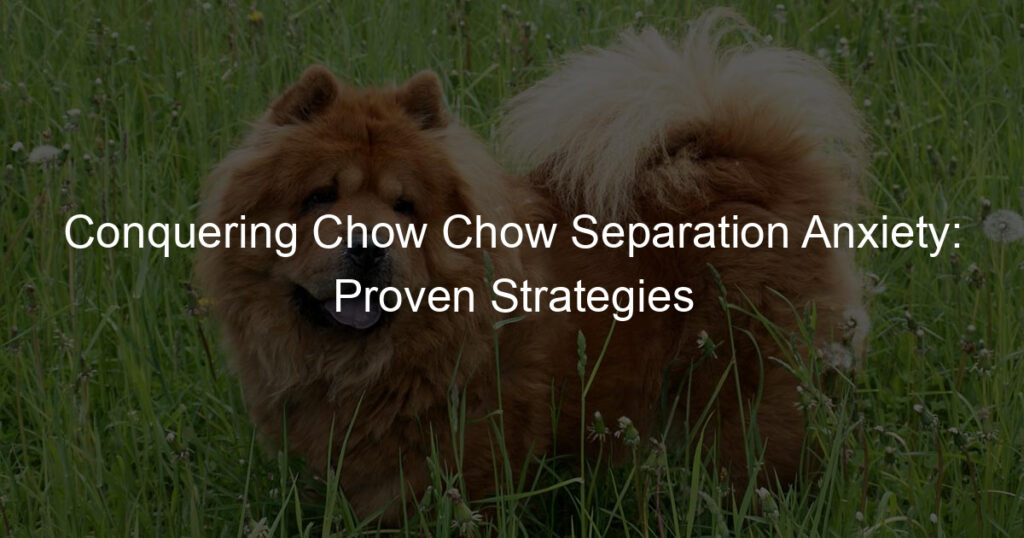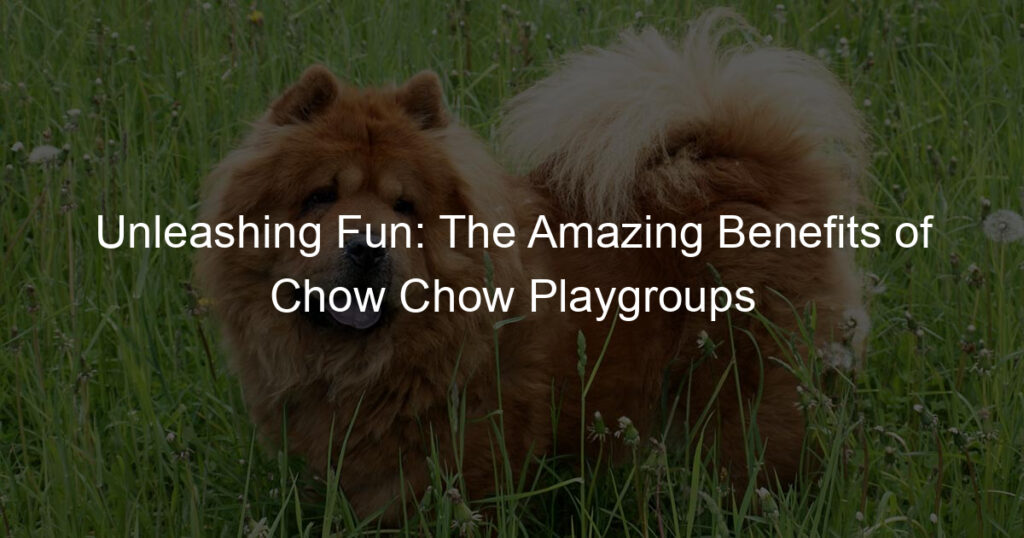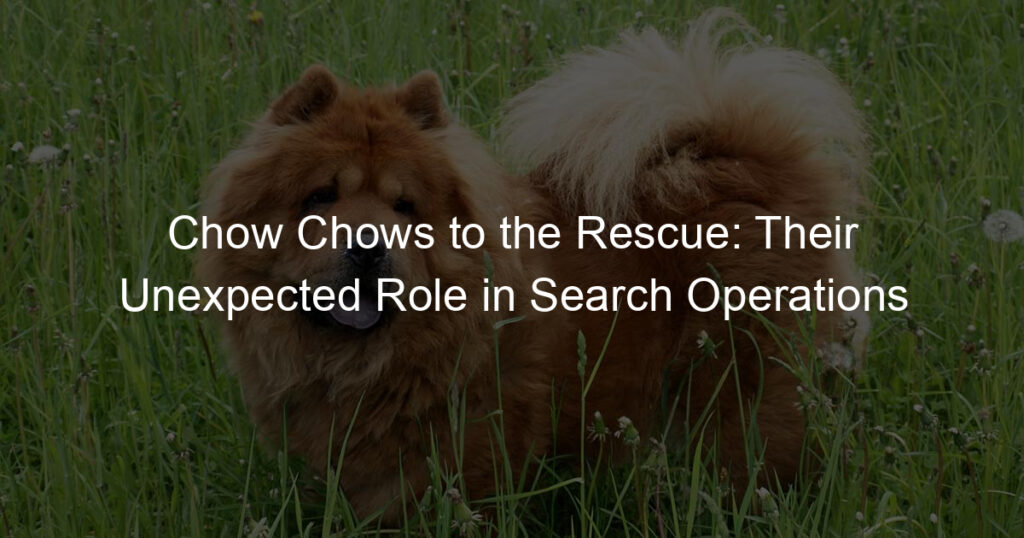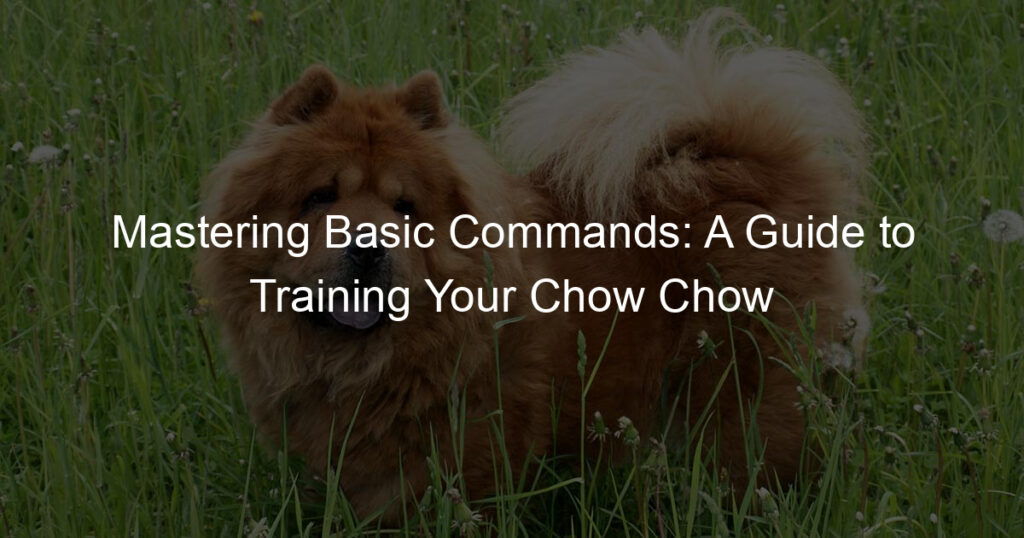Understanding Chow Chow Separation Anxiety
Separation anxiety is a common issue among dogs, and Chow Chows are no exception. It’s essential to understand what this condition is, how to recognize it, and what causes it to help your furry friend. Let’s dive in!
Separation anxiety in Chow Chows is a state of distress that your pet may experience when left alone or separated from you. It’s not just about missing you; it’s a more severe condition that can lead to destructive behavior and health issues if not addressed.
Every Chow Chow may show different signs of separation anxiety. However, some common ones include excessive barking or howling when left alone, destructive behavior like chewing furniture or scratching doors, and even attempts to escape from the house. Some dogs may also show signs of depression or lack of appetite.
Several factors can contribute to separation anxiety in Chow Chows. These can include a sudden change in schedule, moving to a new home, or even the loss of a family member. It’s also common in dogs that have been adopted from a shelter, as they may have experienced traumatic events in their past.
Understanding your Chow Chow’s separation anxiety is the first step to helping them overcome it. In the following sections, we’ll explore ways to deal with this anxiety, behavioral problems that may arise, and training techniques to help your Chow Chow feel more secure.
Dealing with Chow Chow Anxiety
Chow Chows are known for their loyalty and affection towards their owners. However, this can sometimes lead to anxiety when they are left alone. Here are some strategies to help your Chow Chow deal with separation anxiety.
Strategies for Dog Separation Anxiety
Separation anxiety in dogs can be challenging to manage, but with patience and consistency, you can help your furry friend feel more comfortable when you’re not around. Here are some strategies that can help.
-
- Creating a Safe Space
One of the first steps in dealing with Chow Chow anxiety is creating a safe space for your pet. This could be a special room or a corner of your living room with their favorite toys and blankets. This space should be a place where they feel secure and comfortable, even when you’re not there.
-
- Establishing a Routine
Chow Chows thrive on routine. Establishing a daily schedule for meals, walks, and playtime can help reduce their anxiety. Consistency gives them a sense of security and helps them understand what to expect, reducing their stress when you’re not around.
-
- Gradual Desensitization
Gradual desensitization is a technique that involves slowly getting your Chow Chow used to being alone. Start by leaving them alone for a few minutes at a time, then gradually increase the duration. Over time, your pet will become more comfortable being alone, reducing their separation anxiety.
Remember, every dog is unique, and what works for one Chow Chow might not work for another. It’s important to be patient and consistent, and don’t hesitate to seek professional help if needed.
Chow Chow Behavior Problems
Chow Chows are known for their unique personalities and distinct appearances. However, like any other breed, they can exhibit certain behavior problems. Understanding these issues is the first step towards addressing them effectively.
Identifying Behavior Problems
Behavior problems in Chow Chows can manifest in various ways. Here are some of the most common issues:
- Aggression: Chow Chows can sometimes display aggressive behavior. This could be due to fear, territorial instincts, or lack of socialization. It’s important to remember that aggression is not a natural trait of the breed, but a behavior problem that needs to be addressed.
- Excessive Barking: While Chow Chows are not typically noisy dogs, they can resort to excessive barking when they are bored, anxious, or seeking attention. This behavior can be disruptive and may indicate underlying issues.
- Destructive Behavior: Destructive behavior, such as chewing on furniture or digging in the yard, can be a sign of boredom or anxiety. It’s crucial to provide your Chow Chow with enough mental and physical stimulation to prevent such behavior.
Identifying these behavior problems early on can help prevent them from escalating. It’s always best to consult with a professional if you’re unsure about your Chow Chow’s behavior.
Addressing Behavior Problems
Addressing behavior problems in Chow Chows can be a challenging task, but with the right approach, it is entirely possible. Here are three effective methods:
-
- Positive Reinforcement
Positive reinforcement is a powerful tool in addressing behavior problems. This method involves rewarding your Chow Chow for good behavior, which encourages them to repeat it. For example, if your Chow Chow sits quietly instead of barking excessively, reward them with a treat or a pat on the head. This will make them understand that good behavior leads to rewards.
-
- Professional Training
Professional training is another effective method for addressing behavior problems. A professional dog trainer has the knowledge and experience to handle various behavior issues. They can provide a structured training program tailored to your Chow Chow’s needs. This can help your dog learn to behave appropriately in different situations. Remember, consistency is key in training. It’s important to continue the training exercises at home to reinforce what your dog has learned.
-
- Medication (if necessary)
In some cases, medication may be necessary to address behavior problems in Chow Chows. This is usually the last resort when other methods have failed. It’s important to consult with a vet before giving your dog any medication. They can prescribe the right medication and dosage based on your dog’s health condition and behavior issues.
Addressing behavior problems in Chow Chows requires patience and consistency. But with the right approach, you can help your dog become a well-behaved member of your family.
Training Chow Chows
Training your Chow Chow can be a rewarding experience. This breed is known for its intelligence and stubbornness, which can make training a bit challenging. However, with the right techniques, you can successfully train your Chow Chow to be obedient and well-behaved.
Chow Chow Training Techniques
There are several effective techniques you can use to train your Chow Chow. Here are three of the most popular methods:
-
- Clicker Training
Clicker training is a method that uses a device to make a distinct sound, usually a click, to tell your dog when they’ve done something correctly. This technique is based on the principles of operant conditioning, which means your Chow Chow will learn to associate the sound of the click with a reward. This method is effective because it provides immediate feedback, helping your dog understand exactly what behavior is being rewarded.
-
- Leash Training
Leash training is essential for any dog, but especially for a Chow Chow. This breed can be quite independent and may try to lead the way during walks. Leash training helps establish you as the leader and teaches your dog to walk calmly by your side. Start by practicing in a quiet, distraction-free environment and gradually introduce more distractions as your Chow Chow becomes more comfortable on the leash.
-
- Command Training
Command training involves teaching your Chow Chow to respond to specific verbal or hand signals. Start with simple commands like “sit”, “stay”, and “come”. Be consistent with your commands and reward your dog immediately when they respond correctly. Remember to be patient, as it may take time for your Chow Chow to understand and respond to commands.
Remember, every dog is unique and what works for one Chow Chow might not work for another. It’s important to be patient and consistent, and to always reward good behavior. With time and effort, your Chow Chow will become a well-trained and obedient companion.
Chow Chow Anxiety Tips
Chow Chows are known for their loyalty and affection towards their owners. However, they can also suffer from anxiety, especially when left alone. Here are some tips to help manage your Chow Chow’s anxiety.
Managing Chow Chow Separation Anxiety
Separation anxiety in Chow Chows can manifest in various ways, such as excessive barking, destructive behavior, and even attempts to escape. Here are some strategies to help manage this issue:
-
- Exercise and Mental Stimulation
Regular exercise and mental stimulation can help reduce your Chow Chow’s anxiety. This can be achieved through daily walks, playtime, and training sessions. Mental stimulation can also be provided through puzzle toys and interactive games. Remember, a tired dog is a happy dog!
-
- Comfort Items
Providing your Chow Chow with comfort items such as a favorite toy or a piece of your clothing can help soothe their anxiety when you’re not around. The familiar scent can provide a sense of security and comfort.
-
- Professional Help
If your Chow Chow’s anxiety is severe, it may be beneficial to seek professional help. A professional dog trainer or a veterinary behaviorist can provide tailored strategies and treatments to help manage your dog’s anxiety.
Remember, every Chow Chow is unique and what works for one may not work for another. It’s important to be patient and consistent in your approach. With time and effort, you can help your Chow Chow feel more secure and less anxious.
Chow Chow Anxiety Solutions
Chow Chows are wonderful pets, but like any other breed, they can experience anxiety. This can manifest in various ways, such as destructive behavior or excessive barking. However, there are solutions to help your Chow Chow overcome their anxiety.
Overcoming Chow Chow Separation Anxiety
Separation anxiety is a common issue among Chow Chows. They are a breed that forms strong bonds with their owners, and when left alone, they can become anxious. Here are some strategies to help your Chow Chow cope with separation anxiety:
-
- Consistent Training
Consistent training is key in helping your Chow Chow overcome separation anxiety. Start by leaving your pet alone for short periods and gradually increase the time. Reward your Chow Chow for calm behavior when you return. This helps them understand that being alone is not a bad thing.
-
- Patience and Understanding
It’s important to show patience and understanding with your Chow Chow. Remember, they are not misbehaving on purpose. They are simply reacting to their feelings of anxiety. Never punish your Chow Chow for behavior related to separation anxiety. Instead, reassure them and provide comfort when needed.
-
- Seeking Professional Guidance
If your Chow Chow’s separation anxiety is severe, it may be beneficial to seek professional guidance. A professional dog trainer or a veterinary behaviorist can provide strategies and techniques to help manage your pet’s anxiety. They can also determine if medication might be necessary.
Remember, overcoming anxiety is a process. It takes time, patience, and consistency. But with the right approach, your Chow Chow can learn to cope with their anxiety and live a happier, more relaxed life.
Case Studies
Let’s delve into some real-life examples of Chow Chows who have successfully overcome their separation anxiety. These case studies will provide you with a clearer understanding of the issue and the effective strategies used to combat it.
Success Stories of Overcoming Chow Chow Separation Anxiety
-
Case Study 1: Bella’s Transformation
Bella, a 3-year-old Chow Chow, used to howl and destroy furniture whenever her owners left the house. After implementing a consistent routine and using positive reinforcement techniques, Bella’s owners noticed a significant improvement. Within a month, Bella was able to stay alone for up to 4 hours without showing signs of distress.
-
Case Study 2: Max’s Journey
Max, a 2-year-old Chow Chow, would refuse to eat and show signs of extreme distress when left alone. His owners started using a combination of desensitization and counter-conditioning techniques. They gradually increased the time Max spent alone, starting with just a few minutes. After 6 weeks of consistent training, Max was able to stay alone for a whole workday without any anxiety symptoms.
-
Case Study 3: Daisy’s Breakthrough
Daisy, a 4-year-old Chow Chow, used to bark incessantly and pace around the house when left alone. Her owners decided to seek professional help and hired a dog behaviorist. The behaviorist recommended a combination of medication and behavior modification techniques. After 3 months of treatment, Daisy’s separation anxiety symptoms had drastically reduced.
These success stories illustrate that with patience, consistency, and the right strategies, it’s possible to help your Chow Chow overcome separation anxiety. Remember, every dog is unique, and what works for one might not work for another. It’s crucial to find a solution that suits your Chow Chow’s specific needs.
Key Takeaways
As we conclude our discussion on Chow Chow separation anxiety, let’s summarize the most important points we’ve covered. These key takeaways will help you better understand and manage your pet’s anxiety.
-
- Understanding the Root Cause
Every Chow Chow’s anxiety can be traced back to a specific cause. It could be due to a traumatic past experience, lack of socialization, or a sudden change in their environment. Understanding the root cause is the first step towards effectively managing your pet’s anxiety.
-
- Implementing Effective Strategies
Once you’ve identified the root cause, you can start implementing effective strategies to manage your Chow Chow’s anxiety. This could include creating a safe space for them, providing them with toys and activities to keep them engaged when you’re not around, and gradually desensitizing them to the source of their anxiety.
-
- Consistency is Key
Consistency is crucial in managing your pet’s anxiety. Regular routines and consistent training will help your Chow Chow feel more secure and less anxious. Remember, it’s not about quick fixes but about creating a stable environment for your pet.
-
- Seeking Professional Help
If your Chow Chow’s anxiety persists despite your best efforts, don’t hesitate to seek professional help. A professional dog trainer or a veterinary behaviorist can provide you with expert advice and tailored strategies to manage your pet’s anxiety.
In conclusion, managing Chow Chow separation anxiety requires understanding, patience, and consistency. With the right strategies and professional help, you can help your pet lead a happier, less anxious life.














